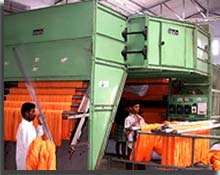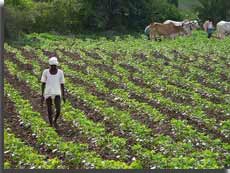| Size of the INDUSTRY | During the year 2008-09, the cotton exports from the country reached at US$ 850 million including 35 lakh bales. |
| Market Capitalization | It contributes about 14% to the industrial production, 4% to the GDP and 14.42% to the country's export earnings. |
| Geographical distribution | Punjab, Haryana, Rajasthan, Maharashtra, Madhya Pradesh, Gujarat. Andhra Pradesh, Karnataka and Tamil Nadu |
| Percentage in World Market | India presently produces 4.59 million tonnes of cotton with 27 million bales of 170 kgs each which constitutes 18% of the world cotton production |

Hugh Mason, Chairman of the Board of the Manchester Cotton Company in 1862, sought the impeachment of Sir Charles Wood (1800-1885), Secretary of State for India. Mason felt the Government of India was holding to a do-nothing policy regarding the provision of greater supplies of raw cotton to Manchester`s manufacturers. The Lancashire Cotton Industry had emerged sufficient pressure on the Secretary of State for India to have the Government of India place a 5% tariff on Indian cotton manufactures in order to allow British cotton goods to be more marketable in India. 64 jute mills existed in Bengal, with 36,000 looms employing a total of 225,000 workers in 1913.

Indian Cotton Industry has an overwhelming presence in the economic life of the country. Apart from providing one of the basic necessities of life, the Cotton industry also plays a pivotal role through its contribution to industrial output, employment generation and the export earnings of the country. It contributes about 14% to the industrial production, 4% to the GDP and 14.42% to the country's export earnings. India is the only country which grows all four species of cultivated cotton starting from Gossypium arboreum and herbaceum (Asian cotton), G.barbadense (Egyptian cotton) and G.hirsutum (American Upland cotton). Gossypium hirsutum represents 90% of the hybrid Indian cotton production and all the current BT cotton hybrids are G.hirsutuim. India produces large number of cotton varieties and hybrids. Though the number of varieties in cultivation exceeds 75, 98% of the production is contributed by about 25 varieties only.

|
Year
|
Qty. (in lakh bales of 170 kgs each) |
Value (in US$ million) |
|
2006-07
|
58.00 |
1170 |
|
2007-08
|
88.50 |
1850 |
|
2008-09
|
35.00 |
850 |
|
2009-10
|
55.00 |
NA |
Government of India as a part of measures to boost cotton trade had liberalized raw cotton exports since July 2001, dispensing with the system of allocation of cotton export quota in favour of different agencies and traders. Exports of cotton has been done under Open General Licence (OGL) since July 2001. During the year 2008-09 in the country, the cotton exports reached at US$ 850 million including 35 lakh bales. The Indian Cotton industry was worth approximately $38 billion, with growth of the industry heavily correlated with the rise and fall of cotton prices. However, exports of cotton have grown steadily throughout the last decade which reached $4.87 billion in 2006.
The Indian Cotton Industry provides livelihood to farmers, and workers engaged in ginning, spinning, weaving, dyeing, designing and packaging, not leaving sewing and tailoring.
- In the year 2008-09 the yield gap between the world and India was narrowed down, as Indian yield was 5.5% to 591 kg per hectare. India still has miles to go before it can match yield levels in countries like Australia, China and the U.S. where yield is as high as 1840 kg, 1265 kg and 985 kg, respectively.
- The major achievement for Indian cotton has been a significant improvement in cotton yield in the last three to four years. The average national yield has almost doubled to 560 kilograms (kg) per hectare, climbing from around 300 kg per hectare as recently as 2002/03. Though the national yield level still compares poorly with the global average of 785 kg per hectare, world average yield grew by just 38% between 2000/01 and 2007/08. Conversely, India's average yield posted a whopping growth of 102% during the same period.
- Today Cotton crop contributes about 14 - 16% to the total agricultural-crop in India.
- India has the largest area under cotton with 9 million hectares in the world constituting 26% of total world cotton area.
- India presently produces 4.59 million tonnes of cotton with 27 million bales of 170 kgs each which constitutes 18% of the world cotton production.
- 60 million people including 4.5 million farmers in India depend on cotton production to earn their livelihood.
- India Cotton Industry may boost the acreage to at least 10.5 million hectares. Farmers planted the crop across 10.4 million hectares and up 9 % from a year earlier, according to the farm ministry in the year 2009.
 Recent Press Release
Recent Press Release
 INDIAN cotton Industry AT A Glance IN 2021 - 2022
INDIAN cotton Industry AT A Glance IN 2021 - 2022
 INDIAN cotton Industry AT A Glance IN 2020 - 2021
INDIAN cotton Industry AT A Glance IN 2020 - 2021
 INDIAN cotton Industry AT A Glance IN 2019 - 2020
INDIAN cotton Industry AT A Glance IN 2019 - 2020
 INDIAN cotton Industry AT A Glance IN 2018 - 2019
INDIAN cotton Industry AT A Glance IN 2018 - 2019
 INDIAN cotton Industry AT A Glance IN 2017 - 2018
INDIAN cotton Industry AT A Glance IN 2017 - 2018
 INDIAN cotton Industry AT A Glance IN 2016 - 2017
INDIAN cotton Industry AT A Glance IN 2016 - 2017
 INDIAN cotton Industry AT A Glance IN 2015 - 2016
INDIAN cotton Industry AT A Glance IN 2015 - 2016
 INDIAN cotton Industry AT A Glance IN 2014 - 2015
INDIAN cotton Industry AT A Glance IN 2014 - 2015
 INDIAN cotton Industry AT A Glance IN 2013 - 2014
INDIAN cotton Industry AT A Glance IN 2013 - 2014
 INDIAN cotton Industry AT A Glance IN 2012 - 2013
INDIAN cotton Industry AT A Glance IN 2012 - 2013
 INDIAN cotton Industry AT A Glance IN 2011 - 2012
INDIAN cotton Industry AT A Glance IN 2011 - 2012
 Cotton Association of India
Cotton Association of India
Indian Industries


